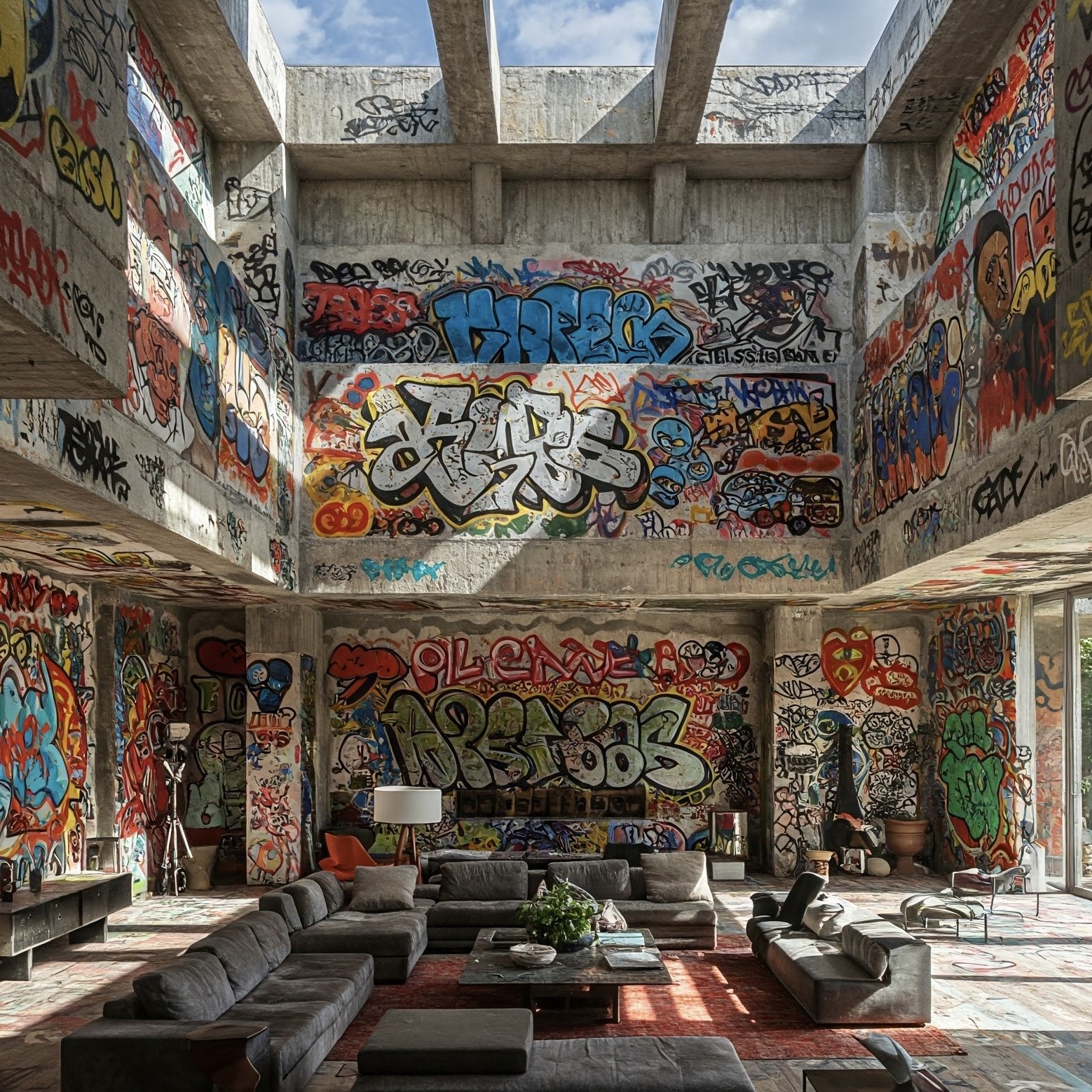A Living Canvas of Street Art and Luxury
In the ever-evolving dialogue between architecture, art, and culture, few styles have been as polarizing as Brutalism and graffiti. Once the unapologetic face of modernist ambition, Brutalist architecture fell out of favor, dismissed as cold, oppressive, and unrefined. Graffiti rose to prominence as a rebellious art form, but it had to face societal rejection before being embraced as a legitimate cultural movement. Yet, some still see street art as nothing more than vandalism and brutalist buildings only as the Pruitt-Igoe project. But what if the very elements that once made Brutalism unpopular became its most compelling assets? What if we made peace with Brutalism through vandalism? What if raw walls and rattle can art became a symphony of street culture in a luxury sanctuary?

Imagine a Brutalist luxury home—raw concrete walls, monolithic forms, and an unforgiving honesty of materials—transformed into a vibrant tapestry for street art. Here, spray paint clashes with the stoic permanence of concrete, creating a dialogue between the ephemeral and the enduring. High-end furniture and bespoke fixtures, the hallmarks of traditional luxury, exist in deliberate contrast to the rebellion of graffiti and urban expression. Exotic cars rest in a garage where the walls tell stories in vibrant, anarchic murals and the bedroom is where silk sheets and street art meet. This is not just a house—it is a manifesto.

Brutalism, at its core, was always about authenticity, about stripping architecture down to its bare essence to show the strength of monumental forms that can withstand time. Street art, too, embodies a raw, unfiltered form of expression, a resistance to the polished and the expected with tags that people leave as personal monuments of archeological evidence of existence. The two have known each other for decades as many Brutalist buildings are adorned with street art, so the marriage of these two arts are a natural born aesthetic—it is a cultural evolution bound to exist in at least one statement piece. Graffiti Brutalism challenges our perceptions of refinement, forcing us to reconsider where luxury ends and artistry begins.

Luxury has long been defined by exclusivity, by a controlled and curated environment... This is America. But what if luxury was about something more—about embracing the unpredictable, the spontaneous, and the culturally resonant? A Brutalist home adorned with street art is not merely a house; it is an evolving narrative, one that absorbs the shifting tides of artistic and social movements. It refuses to be static, instead becoming a reflection of the world outside its concrete walls resonating and reverberating with the music played within it by shouting at establishment and tradition with a living canvas of rattle can art.

This bold reimagining of Brutalism is a reminder that architecture does not exist in isolation. It breathes, it absorbs, and it reacts to the culture that surrounds it. Just as street art has transcended its origins to become a respected artistic discipline, so too can Brutalism shed its past criticisms to become a symbol of a new kind of luxury—one rooted in authenticity, cultural engagement, and the celebration of personal expression.

In embracing the very qualities that once pushed it into obscurity, Brutalism may find new life—not as a relic of the past, but as a testament to the future of design, where the walls speak, and the streets echo within them. Graffiti Brutalism is Brutalist architecture meets street art in a bold reimagining that transforms raw concrete into luxury canvases, challenging perceptions of refinement and celebrating architectural evolution and cultural revolution.

What's the precedent for such an outrageous statement piece in desert Architecture? Ancient petroglyphs on the stones of Arizona stand as testament that the more things change, the more they stay the same. Humans have been making their mark throughout all of history. The differences between this graffiti and todays street art matter less than the similarities. Graffiti is a timeless tradition. Bringing graffiti back into the home is a return to design from the dawn of time when people drew on their cave walls and surrounding stones. Graffiti Brutalism simply brings the idea forward to today to uncage art from frames and show contempt for canvas to put decoration directly on concrete.

This beckons the question of what might the same idea look like brought forward even further into the future? Who knows? Maybe it's something straight out of Blade Runner like this:

Or maybe it's an ode to Jackson Pollock like this:

Whatever expression it takes on, Graffiti Brutalism now exists to free art from the frame by making the building both the canvas and the art.





Leave a Comment